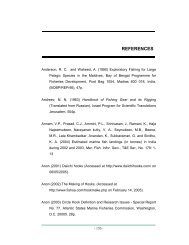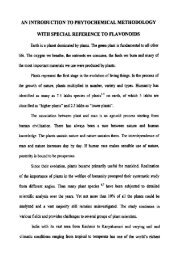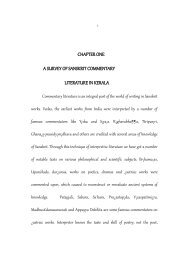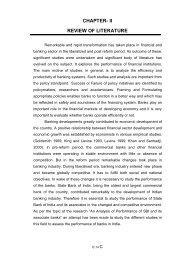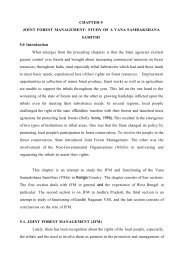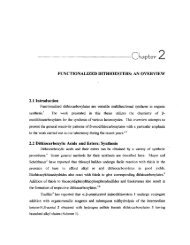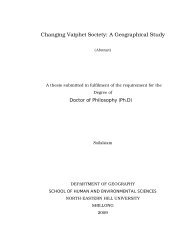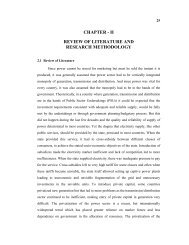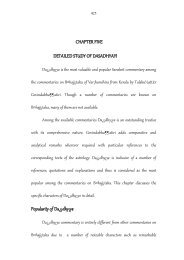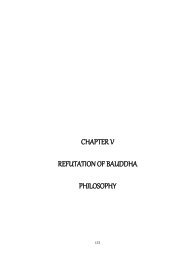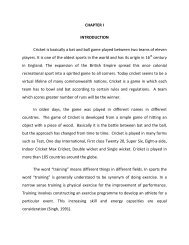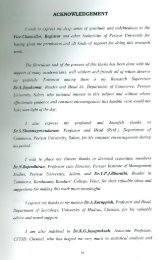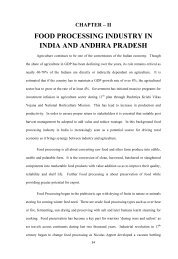09_chapter 3.pdf
09_chapter 3.pdf
09_chapter 3.pdf
Create successful ePaper yourself
Turn your PDF publications into a flip-book with our unique Google optimized e-Paper software.
75<br />
Chapter 3<br />
1,3-DIPOLAR CYCLOADDITION REACTIONS OF NITRONES<br />
3.1. Abstract<br />
3.2. Introduction<br />
This <strong>chapter</strong> deals with the reactions of various<br />
nitrones with dibenzoylacetylene followed by the<br />
chemical transformations of the 1:1adducts formed.<br />
The experimental observations are explained on the<br />
basis of a stepwise addition involving zwitterionic<br />
intermediates.<br />
1,3-Dipolar cycloaddition reactions constitute one of the most<br />
important classes of organic reactions. The ease of generation of various<br />
dipoles as well as the observed regio- and stereoselective nature of their<br />
addition to π-systems made 1,3-dipolar cycloaddition reactions a universal<br />
protocol for the synthesis of various heterocycles. 1-3 Nowadays, 1,3-dipolar<br />
cycloaddition reactions are employed in almost every sphere of chemistry,<br />
including, material chemistry, medicinal chemistry, biochemistry, etc. 4-15<br />
In the context of our general interest in developing novel classes of<br />
heterocycles by utilising various strategies, 16-19 in the present study we<br />
employed 1,3-dipolar cycloaddition reactions as an excellent method for the<br />
synthesis of nitrogen and oxygen heterocycles.
1,3-Dipolar Cycloaddition Reactions of Nitrones<br />
1,3-Dipolar cycloaddition reaction of nitrones has attracted<br />
considerable attention as one of the most important methods for the<br />
construction of nitrogen and oxygen heterocycles. 20 Nitrones undergo facile<br />
cycloaddition reactions with alkenes and alkynes to yield isoxazolidines and<br />
isoxazolines respectively. For e.g., reaction of N-t-butyl-N-methylenenitrone<br />
with dimethyl acetylenedicarboxylate at 0 o C leads to the formation of<br />
4-isoxazoline. 21 Due to thermal instability, presumably related to the presence<br />
of labile nitrogen-oxygen bond, the isoxazolines thus formed have a tendency<br />
to undergo rearrangements to various other products. Baldwin et al. reported<br />
the thermal isomerisation of 4-isoxazoline 3 formed during the reaction<br />
between N-2,4,6-trimethylphenyl-N-methylenenitrone (1) and dimethyl<br />
acetylenedicarboxylate (2) to the corresponding 4-oxazoline 5 via the<br />
acylaziridine intermediate 4 at 80 o C. He observed that, the reaction was quite<br />
rapid at RT in the case of N-arylnitrones and rate of conversion of<br />
4-isoxazoline to acylaziridine was accelerated relative to the subsequent<br />
isomerisation to 4-oxazoline. This may be due to the fact that, an N-aryl<br />
substituent would be expected to further weaken the labile N–O bond. The<br />
4-oxazoline, being a highly labile compound, readily hydrolysed to<br />
formaldehyde and enol 6 (mixture of cis- and trans-enols) with dil. HCl<br />
(Scheme 3.1). 22<br />
76
H 2C<br />
N O<br />
+<br />
CO 2Me<br />
CO 2Me<br />
MeO 2C<br />
77<br />
N O<br />
CO 2Me<br />
1 2 3 4<br />
HO CO 2Me<br />
HN<br />
6<br />
CO 2Me<br />
Scheme 3.1<br />
H +<br />
-CH 2O<br />
O<br />
N<br />
5<br />
N<br />
Chapter 3<br />
CO 2Me<br />
O<br />
CO 2Me<br />
CO 2Me<br />
CO 2Me<br />
Winterfeldt et al. reported yet another type of rearrangement of<br />
4-isoxazolines to pyrroles. 23,24 Upon cycloaddition with methyl propiolate (8),<br />
nitrone 7 gives 4-isoxazoline 9 that rearranges to a mixture of pyrroles 10 and<br />
11 (Scheme 3.2). It is likely that 10 derived via the 2-acylaziridine<br />
rearrangement route (Path 1); whereas pyrrole 11 is assumed to be assembled<br />
by a reaction path involving a sequence of hydroxylamine formation, a hetero-<br />
Cope rearrangement, and finally cyclisation (Path 2). (See Sec. 3.3.10 for<br />
proposed stepwise mechanism)
1,3-Dipolar Cycloaddition Reactions of Nitrones<br />
MeO 2C<br />
+<br />
N O<br />
CO2Me CO 2Me<br />
H<br />
78<br />
MeO 2C<br />
MeO 2C<br />
MeO 2C<br />
7 8 9<br />
MeO 2C<br />
MeO 2C<br />
MeO 2C<br />
MeO 2C<br />
MeO 2C<br />
MeO 2C<br />
CO 2Me<br />
N O<br />
CO 2Me<br />
NH<br />
N<br />
11<br />
Path 2<br />
CHO<br />
-H 2O<br />
CO 2Me<br />
Scheme 3.2<br />
N O<br />
Path 1<br />
MeO 2C<br />
MeO 2C<br />
MeO 2C<br />
MeO 2C<br />
MeO 2C<br />
MeO 2C<br />
MeO 2C<br />
N<br />
N<br />
N<br />
CHO<br />
CO 2Me<br />
CHO<br />
CHO<br />
-H 2O<br />
CO 2Me<br />
CO 2Me<br />
MeO2C N<br />
CO2Me Nitrones can also react with ketenes, ketenimines, isocyanates,<br />
isothiocyanates, etc. For e.g., the reaction between C,N-diphenylnitrone (12)<br />
and diphenylketene 13 results in the formation of the phenylimino<br />
10
79<br />
Chapter 3<br />
derivative 16 (Scheme 3.3). This transformation is believed to involve initial<br />
O-acylation to give the zwitterion 14, which undergoes a spontaneous<br />
[3,3] sigmatropic rearrangement and subsequent rearomatisation to produce<br />
imino acid 15<br />
derivative 16.<br />
which on decarboxylation affords the phenylimino<br />
25<br />
Ph<br />
H<br />
CHPh<br />
N Ph<br />
16<br />
O<br />
N<br />
Ph<br />
+<br />
∆<br />
-CO 2<br />
Ph 2C C O<br />
12 13 14<br />
Ph<br />
CHPh<br />
N<br />
O OH<br />
Ph<br />
15<br />
Ph<br />
PhHC O<br />
N<br />
Scheme 3.3<br />
Ph<br />
CHPh<br />
N<br />
O<br />
[3,3]<br />
O<br />
Ph<br />
O<br />
Ph<br />
Ph<br />
PhHC<br />
Ph<br />
Ph<br />
H<br />
Ph<br />
N<br />
X<br />
Ph<br />
O<br />
N<br />
O<br />
Ph O<br />
Similarly ketenimine 17 undergoes reaction with N-arylnitrones,<br />
e.g., C,N-diphenylnitrone (12) to afford oxindoles 21, a transformation that<br />
has also been suggested to involve ionic intermediates. Formation of<br />
adduct 20 can be satisfactorily interpreted in terms of the reaction sequence<br />
shown in Scheme 3.4. The process leading to 20 involves initial formation of<br />
zwitterion 18, followed by sigmatropic rearrangement of 18 to the<br />
zwitterion 19 with subsequent hydrogen transfer. The adduct 20, even on<br />
chromatography, is readily hydrolysed to give oxindole 21. 26 It is interesting<br />
to note that dipolar intermediates such as 14 and 18 are reluctant to undergo<br />
O
1,3-Dipolar Cycloaddition Reactions of Nitrones<br />
ring closure - they follow alternative reaction pathway involving<br />
[3,3]-sigmatropic shifts.<br />
N<br />
H<br />
21<br />
Ph<br />
H<br />
O<br />
O<br />
N<br />
Ph<br />
H 3O<br />
+ C C N Ph<br />
PhN CHPh<br />
N<br />
80<br />
CHPh<br />
HN<br />
O<br />
Ph<br />
N CHPh<br />
O<br />
N<br />
Ph<br />
12 17 18<br />
−<br />
20<br />
Scheme 3.4<br />
H<br />
N<br />
19<br />
[3,3]<br />
CHPh<br />
Besides their synthetic applications, the mechanism of<br />
1,3-dipolar cycloaddition has also been intensively investigated. Concerted or<br />
stepwise is the central question of 1,3-dipolar cycloaddition chemistry. Most<br />
of the evidences for concertedness are indirect. As described in Chapter 1,<br />
Huisgen observed scrambling of stereochemistry in the products formed by the<br />
reaction between a highly electron-rich thiocarbonyl ylide dipole and an<br />
electron-deficient dipolarophile, for example a dicyano-substituted alkene.<br />
This is considered as the first two step 1,3-dipolar cycloaddition reaction via<br />
zwitterionic intermediate. 27 As a mechanistic criterion, capturing of an<br />
intermediate has the power of conviction. That has been achieved by the<br />
interception of intermediate formed during the reaction between thiocarbonyl<br />
ylide and tetracyanoethylene. 28 Quast et al. was able to isolate a zwitterionic<br />
intermediate 24 in the reaction of strongly electrophilic azides 23 with<br />
N<br />
O<br />
Ph
81<br />
Chapter 3<br />
5-alkylidenedihydrotetrazoles 22. The zwitterion 24 quantitatively affords<br />
tetrazine 26 via the elimination of nitrogen from the adduct 25 (Scheme 3.5). 29<br />
N N +<br />
N N<br />
O2 S N<br />
N 3<br />
N N<br />
N N<br />
SO 2<br />
−N 2<br />
SO2 N<br />
N<br />
N<br />
N N<br />
N<br />
N<br />
22 23 24<br />
26<br />
Scheme 3.5<br />
O2 S N<br />
N N<br />
N<br />
N N<br />
N<br />
From literature analysis, it is obvious that there is a lively debate on<br />
the mechanism of 1,3-dipolar cycloaddition reactions. Modest amount of<br />
theoretical work has also been performed on 1,3-dipolar addition mechanism.<br />
Most of the theoretical studies are focussed on the concerted nature of<br />
1,3-dipolar cycloadditions. 30-33 Some of the advanced computational studies<br />
carried out on different systems lead to the conclusion that the dipoles follow<br />
both concerted and stepwise paths and these paths may be in close<br />
competition. 34-36 We reasoned that a 1,3-dipole that exhibits substantial<br />
nucleophilic character can undergo overall cycloaddition through a two step<br />
nucleophilic addition-ring closure sequence. The dipolarophile should ideally<br />
contain anion stabilizing groups that will make it an excellent<br />
25
1,3-Dipolar Cycloaddition Reactions of Nitrones<br />
Michael acceptor. Nucleophilic character of nitrones is well established (vide<br />
infra) and dibenzoylacetylene is an excellent Michael acceptor. Thus, the<br />
reaction between suitable nitrones and dibenzoylacetylene should provide an<br />
ideal platform to examine competing nucleophilic addition-ring closure<br />
sequence and concerted 1,3-dipolar cycloaddition reaction. In the present<br />
<strong>chapter</strong> we describe our findings on the reaction of various nitrones with<br />
DBA. Contrary to conventional wisdom, the reactions yielded a different set<br />
of products. Their formation is better explained on the basis of a stepwise<br />
reaction involving zwitterionic intermediates. Our findings, thus, represent a<br />
breakthrough in the longstanding impasse on the mechanism of 1,3-dipolar<br />
cycloaddition.<br />
3.3. Results and Discussion<br />
In an attempt to study the mechanism involved in 1,3-dipolar<br />
cycloaddition reactions, we selected nitrones and dibenzoylacetylene (DBA)<br />
as the 1,3-dipole and dipolarophile respectively. While selecting the reaction<br />
between nitrones and DBA as a platform to investigate the mechanistic<br />
intricacies of 1,3-dipolar additions, as stated earlier, we bore the following<br />
points in mind: 1) nitrones undergo nucleophilic addition to ketenes and<br />
keteneimines, 2) DBA is an excellent Michael acceptor, and 3) the expected<br />
isoxazoline product generated in the reaction between nitrones and DBA is<br />
generally perceived to be unstable. Hence we reasoned that a stepwise<br />
mechanism is plausible for 1,3-dipolar addition of DBA to nitrones and<br />
dipolar intermediate generated in the putative Michael type addition step may<br />
have to cross a substantial energy barrier to overcome adverse steric<br />
interactions with α-C substituents and to undergo ring closure to give the<br />
presumably unstable isoxazoline derivatives (Scheme 3.6).<br />
82
O<br />
Ph<br />
R 1<br />
R 2<br />
PhOC<br />
R 1<br />
R 2<br />
+<br />
O<br />
N<br />
Ar<br />
N O<br />
Ar<br />
COPh<br />
COPh<br />
MeCN<br />
RT<br />
O<br />
Ph<br />
O<br />
Ph<br />
83<br />
R 1<br />
R 2<br />
R 1<br />
R 2<br />
C<br />
C<br />
Scheme 3.6<br />
COPh<br />
O<br />
N<br />
Ar<br />
COPh<br />
O<br />
N<br />
Ar<br />
R 1<br />
R 2<br />
O<br />
N<br />
Ar<br />
Chapter 3<br />
COPh<br />
C<br />
Ph<br />
O<br />
Other transformations<br />
Nitrones chosen for our present study are given in Figure 3.1. It is<br />
evident that, on moving from nitrones 27 to 29, the steric crowding on α-C of<br />
nitrones is reduced which may affect the course of reaction. One of the<br />
reasons for the selection of DBA as dipolarophile is that, introduction of<br />
electron withdrawing substituents into an acetylenic dipolarophile will<br />
increase rate constants by several orders. Another reason is that, negative<br />
charge on the zwitterions, if formed, will be stabilized by anion stabilizing<br />
groups.<br />
Dibenzoylacetylene was prepared by a known three step procedure. 37<br />
The first step involves Friedel-Crafts acylation of benzene with fumaryl<br />
chloride to give trans-dibenzoylethylene, which on bromination followed by<br />
dehydrobromination using triethylamine give DBA quantitatively.
1,3-Dipolar Cycloaddition Reactions of Nitrones<br />
O<br />
N<br />
X= a) H, b) CH 3, c) Cl<br />
84<br />
O<br />
N<br />
H<br />
O<br />
N<br />
X<br />
X<br />
27a-c 28a-c 29a-c<br />
O<br />
N<br />
30<br />
Figure 3.1<br />
3.3.1. Reactions of N-Fluorenylidene-N-arylnitrones with DBA<br />
1,3-Dipolar cycloaddition reaction between N-fluorenylidene-N-aryl<br />
nitrones 27a-c and dibenzoylacetylene (31) is conducted in 1:1 molar ratio at<br />
RT in dry acetonitrile. It is found that the reaction is practically complete<br />
within 4 h. The reaction results in the formation of three products (Scheme<br />
3.7). The overall conversion is found to be ~90% (wt %). CHN and MS data<br />
of the compounds reveal that one of the products is a 1:1 adduct and the sum<br />
of m/z values of other two compounds are found to be exactly equal to<br />
(1:1 adduct + H2O) and are formed in 1:1 ratio. On the basis of spectral and<br />
analytical data the compound with smallest molecular mass (M+1 =181) is<br />
identified as 9-fluorenone (32). The structure is further confirmed by<br />
comparing the spectral and analytical data of an authentic sample.<br />
X
O<br />
N<br />
27a-c<br />
X<br />
+<br />
COPh<br />
COPh<br />
X= a) H, b) CH 3, c) Cl<br />
MeCN<br />
RT, 4h<br />
O +<br />
85<br />
X<br />
N<br />
O<br />
O<br />
OH<br />
+<br />
X<br />
Chapter 3<br />
31 32 33a-c 34a-c<br />
X<br />
Product yield, %<br />
32 33 34<br />
H 13 75 14<br />
CH3 14 76 16<br />
Cl 14 73 15<br />
Scheme 3.7<br />
Spectral data indicate that 1:1 adduct is entirely different from<br />
normal products expected on the basis of a concerted process. The broad peak<br />
at ~3250 cm -1 in IR spectrum of these compounds indicates the presence of a<br />
hydrogen bonded –OH (not expected in the formal adduct). It is supported by<br />
a small broad singlet ~δ 4.2(bs, 0.4H) in 1 H NMR spectrum which is vanished<br />
in the D2O exchange experiment. The aromatic region in 1 H NMR spectrum<br />
shows a complex multiplet. The sharp peak at ~1680 cm -1 in IR spectrum<br />
indicates the presence of a single carbonyl group (two carbonyl groups are<br />
expected in the formal adduct). Presence of the lone carbonyl group is<br />
supported by the peak at ~δ 198 in 13 C NMR spectrum. On the basis of<br />
spectral and analytical data, the results of hydrolysis experiment carried on 1:1<br />
adducts (details are presented in section 3.3.4.) as well as the nucleophilicity<br />
of nitrones and probability for a Michael-type addition of nitrones to<br />
acetylenes, the 1:1 adducts are identified as 3(2H)-furanones 33a-c.<br />
NH<br />
O<br />
O<br />
OH
1,3-Dipolar Cycloaddition Reactions of Nitrones<br />
Conclusive evidence on the structure of 1:1 adducts emerged from<br />
X-ray diffraction studies. The single crystal X-ray diffraction analysis<br />
conducted on the crystals of 33a and 33b, unambiguously confirmed their<br />
proposed structure (Figure 3.2 and 3.3).<br />
Figure 3.2 ORTEP diagram of molecular structure of compound 33a<br />
Figure 3.3 ORTEP diagram of molecular structure of compound 33b<br />
86
87<br />
Chapter 3<br />
After identifying the structure of 33, we focussed our attention on<br />
identifying the structure of the minor product 34 formed in the nitrone-DBA<br />
reaction. As mentioned earlier, compound 34 and fluorenone are generated<br />
during the reaction in a 1:1 ratio suggesting that both are formed from the<br />
same entity. Additionally, the sum of m/z values of compound 34 and<br />
fluorenone is found to be exactly equal to (1:1 adduct + H2O). So there is<br />
every possibility for a hydrolysis step in the course of overall reaction.<br />
Similar results have already been reported in literature. 22 The possibility for<br />
the hydrolysis of 1:1 adducts 33a-c was totally ruled out because it leads to the<br />
formation of other products (3.3.4.). We also found that, compound 34a-c is a<br />
common product irrespective of the substituents on α-C of nitrones (Ref. 3.3.6<br />
and 3.3.8). In the IR spectrum of compounds 34a-c, there is a sharp peak at<br />
~3360 cm -1 and a broad peak at ~3300 cm -1 indicating the presence of –OH<br />
and –NH groups. It is further confirmed by the small broad singlet at ~δ 4.3<br />
(bs, 0.6H) and a comparatively sharp peak at ~δ 5 (s, 0.75H) in the 1 H NMR<br />
spectrum which are vanished in the D2O exchange experiment. The aromatic<br />
region in the 1 H NMR spectrum extends from ~ δ 6.5 to 8.0 as a multiplet.<br />
The sharp peak at ~1675 cm -1 in the IR spectrum shows the presence of a<br />
carbonyl group and is supported by the peak at ~δ 199 in the 13 C NMR<br />
spectrum. Obviously, the carbonyl carbon in compounds 34a-c is in the same<br />
environment as that in compounds 33a-c. Considering the spectral and<br />
analytical data, formation of 34a-c and fluorenone in 1:1 ratio during the<br />
reaction, invariant generation of compounds 34a-c irrespective of the<br />
substituents on α-C of nitrones, and the possibility for cyclisation of the<br />
zwitterionic intermediate formed by the Michael-type addition of nitrones to<br />
acetylenes, the compounds are identified as 3(2H)-furanones 34a-c.
1,3-Dipolar Cycloaddition Reactions of Nitrones<br />
The single crystal X-ray diffraction analysis conducted on crystals of<br />
34a, unequivocally confirmed the proposed 3(2H)-furanone structure<br />
(Figure 3.4)<br />
Figure 3.4 ORTEP diagram of molecular structure of compound 34a<br />
3(2H)-Furanones are widely distributed in nature and possess<br />
unusual range of biological activities. 38-40 Several furanones exhibit tumor<br />
inhibitory properties. 16,41 3(2H)-Furanones are also used as selective COX-II<br />
inhibitors. 42,43 The pharmacological importance of 3(2H)-furanones has led to<br />
the development of efficient methods for their synthesis. In this context, we<br />
recommend the reaction between nitrones and DBA as an alternate efficient<br />
method for the synthesis of novel 3(2H)-furanones (Ref. 3.3.8.).<br />
3.3.2. Reactions of N-Fluorenylidene-N-arylnitrones with DBA in<br />
Refluxing Acetonitrile<br />
When the reaction between nitrone 27a-c and DBA was repeated<br />
under reflux conditions in acetonitrile, the reaction was found to be rather fast,<br />
and a slight variation in product distribution was noticed (Scheme 3.8). We<br />
88
89<br />
Chapter 3<br />
observed an approximately 5% decrease in the percentage yield of 1:1 adducts<br />
with a proportionate increase in percentage yields of other two compounds.<br />
This indicates the presence of two competing pathways out of which one is<br />
energetically less favored compared to the other.<br />
O<br />
N<br />
27a-c<br />
X<br />
X= a) H, b) CH 3, c) Cl<br />
COPh<br />
MeCN<br />
+<br />
Reflux, 1h<br />
COPh<br />
O +<br />
X<br />
31 32 33a-c 34a-c<br />
X<br />
N<br />
O<br />
Product yield, %<br />
32 33 34<br />
H 17 68 18<br />
CH3 20 69 19<br />
Cl 18 66 22<br />
Scheme 3.8<br />
3.3.3. Proposed Mechanism for the Reactions of Nitrones with DBA –<br />
A Stepwise Reaction<br />
Formation of compounds 32, 33a-c and 34a-c can be explained on<br />
the basis of a stepwise addition mechanism. In the first step of reaction, a<br />
zwitterionic intermediate 35a-c is formed by a Michael-type addition of<br />
nitrones 27a-c to DBA. The zwitterionic intermediate can undergo either<br />
cyclisation to normal 1:1 adduct, i.e., 4-isoxazolines 36a-c or it can undergo a<br />
spontaneous hetero-Cope rearrangement {[3,3] sigmatropic rearrangement}<br />
followed by rearomatisation and cyclisation to give 3(2H)-furanones 33a-c.<br />
O<br />
OH<br />
+<br />
X<br />
NH<br />
O<br />
O<br />
OH
1,3-Dipolar Cycloaddition Reactions of Nitrones<br />
4-Isoxazolines are known to undergo isomerisation to the corresponding<br />
4 oxazolines via an aziridine intermediate. As observed by Baldwin et al.,<br />
here the presence of N-aryl substituents may enhance the rate of conversion of<br />
4-isoxazolines to 4-oxazolines. As described earlier, this may be due to the<br />
fact that, an N-aryl substituent would be expected to further weaken the N–O<br />
bond. 21 4-Oxazoline 37, being a highly labile compound, 22 may be readily<br />
hydrolysed to fluorenone (32) and enol 38a-c. The latter on cyclisation will<br />
produce the 3(2H)-furanones 34a-c (Scheme 3.9).<br />
90
Chapter 3<br />
91<br />
C<br />
O<br />
N<br />
COPh<br />
O<br />
Ph<br />
H<br />
O<br />
N<br />
MeCN<br />
COPh<br />
RT<br />
3,3<br />
N<br />
O<br />
Ph<br />
Ph<br />
O<br />
HO<br />
O<br />
Ph<br />
O<br />
N<br />
Ph<br />
Ph<br />
O<br />
O<br />
H<br />
O<br />
N<br />
Ph<br />
Ph<br />
O<br />
O<br />
O<br />
N<br />
Ph<br />
Ph<br />
O<br />
O H<br />
H<br />
O<br />
N<br />
COPh<br />
C<br />
O<br />
Ph<br />
N O<br />
Ph<br />
O<br />
O<br />
Ph<br />
N<br />
O<br />
O<br />
O<br />
Ph<br />
Ph<br />
N<br />
O<br />
O<br />
Ph<br />
O<br />
Ph<br />
N<br />
O<br />
COPh<br />
COPh<br />
O<br />
NH<br />
HO<br />
O<br />
NH<br />
O<br />
Ph<br />
O<br />
Ph<br />
O<br />
H<br />
H 2O<br />
NH<br />
O<br />
Ph<br />
O<br />
Ph<br />
O<br />
H<br />
O<br />
32<br />
34a<br />
33a<br />
35a<br />
37a<br />
38a<br />
27a<br />
+<br />
36a<br />
Scheme 3.9
1,3-Dipolar Cycloaddition Reactions of Nitrones<br />
In order to confirm the mechanism for the formation of<br />
3(2H)-furanones 34 we repeated the reaction between 27 and DBA in<br />
acetonitrile containing water as well as in methanol. Water and methanol may<br />
intercept the zwitterionic intermediate 35 and that may lead to other products,<br />
for example fluorenone and isoxazoline 39 in presence of excess water<br />
(Scheme 3.10). However, no change in products/product distribution was<br />
observed under these conditions. Based on these results, we conclude that<br />
hydrolysis step manifests at a later stage in the reaction sequence as shown in<br />
the previous scheme.<br />
O<br />
Ph<br />
+<br />
O<br />
N<br />
27a<br />
COPh<br />
MeCN<br />
RT<br />
O<br />
Ph<br />
Ph<br />
HO<br />
C<br />
35a<br />
O<br />
N<br />
O<br />
N<br />
Ph<br />
39<br />
92<br />
COPh<br />
COPh<br />
Scheme 3.10<br />
H 2O<br />
X<br />
O<br />
Ph<br />
Ph<br />
H<br />
O<br />
N<br />
C<br />
O<br />
N<br />
OH 2<br />
HO<br />
33a<br />
COPh<br />
COPh<br />
O<br />
OHN<br />
Ph<br />
Ph<br />
O<br />
32<br />
Ph<br />
O
93<br />
Chapter 3<br />
3.3.4. Hydrolysis of N-Fluorenylidene-N-arylnitrone-DBA Adducts<br />
In addition to spectral and analytical data, results from hydrolysis<br />
experiment carried on 1:1 adducts were also helpful to elucidate their<br />
structures. Note that hydrolysis experiment was mandatory to confirm that<br />
34 was not generated by the hydrolysis of 33. Hydrolysis was accomplished<br />
by stirring a mixture of 1:1 adducts 33a-c and oxalic acid adsorbed on silica<br />
gel in DCM at RT for 2h (Scheme 3.11). The products were separated by<br />
column chromatography.<br />
X<br />
Ph<br />
N<br />
O<br />
O<br />
Ph<br />
OH<br />
X= a) H, b) CH 3, c) Cl<br />
H 2C 2O 4/<br />
Silica gel<br />
DCM, RT, 2h<br />
O +<br />
33a-c 32<br />
40a-c<br />
X<br />
Product yield,<br />
%<br />
32 40<br />
H 86 90<br />
CH3 89 87<br />
Cl 88 91<br />
Scheme 3.11<br />
Acidic hydrolysis of 33 led to the formation of two compounds. One<br />
of the two products separated is identified as fluorenone. In the IR spectrum<br />
of other compound there is a broad peak at ~3450 cm -1 indicating the presence<br />
of a hydrogen bonded –OH group. Presence of a comparatively sharp peak at<br />
~δ 8.8 (s, 0.54H) in 1 H NMR spectrum which is vanished in D2O exchange<br />
X<br />
N<br />
O<br />
OH
1,3-Dipolar Cycloaddition Reactions of Nitrones<br />
experiment reveals that, the compound may contain an enolic –OH. The<br />
aromatic region in 1 H NMR spectrum extends from ~ δ 7 to 8.0. The sharp<br />
peak at ~1670 cm -1 in IR spectrum suggests the presence of a carbonyl group<br />
which is supported by the peak at ~δ 198 in 13 C NMR spectrum. Based on<br />
spectral and analytical data, the compound is identified as quinoline 40a-c.<br />
Single crystal X-ray diffraction analysis conducted on crystals of<br />
40b, confirmed the structure of quinolines (Figure 3.5)<br />
Figure 3.5 ORTEP diagram of molecular structure of compound 40b<br />
3.3.5. Proposed Mechanism for the Hydrolysis of N-Fluorenylidene-Narylnitrone-DBA<br />
Adducts<br />
Oxalic acid adsorbed on silica gel is commonly used for mild<br />
hydrolysis. 18,44,45 The first step in the hydrolysis reaction is a typical imine<br />
hydrolysis to give the carbonyl part 32 (fluorenone in the present example)<br />
and the amine 41a-c. The next step is ring opening of 3(2H)-furanone ring<br />
94
95<br />
Chapter 3<br />
system present in the amine component which is followed by re-cyclisation<br />
and aromatization to give quinoline 40a-c (Scheme 3.12).<br />
Ph<br />
N<br />
O<br />
N<br />
O<br />
Ph O<br />
N<br />
H<br />
O<br />
Ph<br />
OH<br />
OH<br />
Ph<br />
OH<br />
OH<br />
Ph<br />
O<br />
O<br />
NH2 33a 41a<br />
40a<br />
-H 2O<br />
H 3O +<br />
32<br />
O<br />
Ph<br />
O<br />
NH2O OH<br />
Ph<br />
Scheme 3.12<br />
Ph<br />
OH<br />
Ph<br />
Ph<br />
O<br />
NH2 H<br />
O<br />
O<br />
O<br />
NH2 H<br />
O Ph<br />
As cited in sec. 3.3.1., the hydrolysis experiment is pivotal to<br />
elucidate the pretty complex structure of 1:1 adducts 33. The disconnection<br />
approach leading us to the structure of 1:1 adducts is given in scheme 3.13.<br />
-H +<br />
O<br />
H<br />
Ph
1,3-Dipolar Cycloaddition Reactions of Nitrones<br />
N<br />
40a<br />
O<br />
OH<br />
OH O<br />
O<br />
NH2 Scheme 3.13<br />
96<br />
Ph<br />
Ph<br />
O<br />
NH2 N<br />
O<br />
O<br />
O<br />
R 2 R 1<br />
3.3.6. Reactions of N-Diphenylmethylene-N-arylnitrones with<br />
DBA<br />
1,3-Dipolar cycloaddition reaction between N-diphenylmethylene-Narylnitrones<br />
28a-c and DBA is conducted in 1:1 molar ratio at RT in dry<br />
acetonitrile (Scheme 3.14).<br />
O<br />
N<br />
28a-c<br />
X<br />
+<br />
COPh<br />
X= a) H, b) CH 3, c) Cl<br />
COPh<br />
MeCN<br />
RT,4h<br />
O +<br />
X<br />
31 42 43a-c 34a-c<br />
X<br />
N<br />
O<br />
Product yield, %<br />
42 43 34<br />
H 24 66 23<br />
CH3 21 64 20<br />
Cl 23 66 22<br />
Scheme 3.14<br />
O<br />
OH<br />
+<br />
X<br />
Ph<br />
OH<br />
Ph<br />
OH<br />
NH<br />
O<br />
O<br />
OH
97<br />
Chapter 3<br />
It is found that the reaction results in the formation of products<br />
similar to those obtained in the reaction between N-fluorenylidene-Narylnitrones<br />
27a-c and DBA. One of the products formed is identified as<br />
3(2H)-furanone 34a-c. On the basis of spectral and analytical data the<br />
compound with smallest molecular mass (M+1 =183) is identified as<br />
benzophenone (42). The structure of 1:1 adduct 43a-c is determined on the<br />
basis of spectral and analytical data (for more details, see experimental<br />
section). The structure is further confirmed by their hydrolysis which leads to<br />
the formation of benzophenone and quinolines 40a-c (3.3.7). There is a<br />
decrease in percentage yield of 1:1 adduct formed during the cycloaddition<br />
reaction (i.e., 75% to 65%), on moving from N-fluorenylidene-N-aryl<br />
nitrones 27a-c to N-diphenylmethylene-N-arylnitrones 28a-c and this may be<br />
due to the decrease in steric barrier offered by the α-C of nitrone. This will<br />
enhance the probability for the cyclisation of zwitterionic intermediate formed<br />
as a result of the Michael-type addition of nitrones to DBA.<br />
3.3.7. Hydrolysis of N-Diphenylmethylene-N-arylnitrone-DBA Adducts<br />
As mentioned above, the structure of the 1:1 adducts 43a-c is<br />
confirmed by the hydrolysis experiment. The hydrolysis with oxalic acid<br />
adsorbed on silica gel results in the formation of benzophenone and<br />
quinoline 40a-c (Scheme 3.15). The products are identified on the basis of<br />
their spectral and analytical data.
1,3-Dipolar Cycloaddition Reactions of Nitrones<br />
X<br />
Ph<br />
N<br />
O<br />
Ph<br />
O<br />
OH<br />
43a-c 42<br />
40a-c<br />
X= a) H, b) CH 3, c) Cl<br />
H 2C 2O 4/<br />
Silica gel<br />
DCM, 2h<br />
98<br />
O +<br />
X<br />
Product yield,<br />
%<br />
42 40<br />
H 83 82<br />
CH3 81 85<br />
Cl 78 81<br />
Scheme 3.15<br />
Quinoline ring system is widely distributed in nature. The alkaloid<br />
quinine is a well known traditional antimalarial drug. The presence of<br />
quinoline nucleus in the framework of various pharmacologically active<br />
compounds with antiasthmatic, 46 antibacterial, 47 antifungal, 48 antimalarial, 49<br />
anti-viral, 50 anti-inflammatory 51 activities triggered an active research in the<br />
realm of synthesis and transformations of quinolines. 8-Hydroxyquinoline is a<br />
versatile chelating agent. Its aluminium complex, tris-(8-hydroxy-quinolinato)<br />
aluminium(III) , generally represented as Alq3, is a commonly used compound<br />
in organic light emitting diodes (OLEDs). 52 The presence of suitably placed<br />
carbonyl and hydroxyl groups in quinoline 40, give rise to the possibility for<br />
their conversion to salen type compounds which can form metal complexes<br />
and make them synthetically attractive. Considering the synthetic as well as<br />
pharmacological potential of quinolines, herein we propose a synthetic loop<br />
for a highly atom efficient synthesis of highly substituted quinolines (Figure<br />
X<br />
N<br />
O<br />
OH
99<br />
Chapter 3<br />
3.6). It is possible to alter substitution pattern by the judicious selection of<br />
acetylenic compounds and appropriate amines (during the synthesis of<br />
nitrones).<br />
R<br />
NH 2<br />
m-CPBA<br />
BF 3.Et 2O<br />
O<br />
R 1 R 2<br />
A<br />
R<br />
HN<br />
C<br />
O<br />
R<br />
IM<br />
O<br />
IM<br />
A<br />
R 1<br />
OH<br />
N<br />
R 2<br />
+<br />
R<br />
R<br />
R 1<br />
NT<br />
N<br />
D<br />
O<br />
O<br />
N<br />
R 2<br />
NT<br />
OH<br />
R<br />
(A+ B+C )<br />
H 2C 2O 4/ SiO 2<br />
Ph<br />
N<br />
O<br />
O<br />
R 1 R 2<br />
B<br />
DBA<br />
Figure 3.6 Proposed synthetic loop for the synthesis of quinolines<br />
3.3.8. Reactions of N-Phenylmethylene-N-arylnitrones with DBA<br />
The reaction between N-phenylmethylene-N-arylnitrones 29a-c and<br />
dibenzoylacetylene was conducted in 1:1 molar ratio at RT in dry acetonitrile<br />
Ph<br />
OH
1,3-Dipolar Cycloaddition Reactions of Nitrones<br />
(Scheme 3.16). In this case, reaction was found to be relatively fast and<br />
completed within a short interval (~20 min). Very interestingly, we noticed<br />
that, the expected 1:1 adduct was not formed in detectable amounts. We could<br />
isolate only two products from the reaction mixture. On the basis of spectral<br />
and analytical data they were identified as benzaldehyde (44) and<br />
3(2H)-furanone 34a-c. This can be explained on the basis of the geometry of<br />
the nitrones. In the case of N-fluorenylidene-N-arylnitrones, the fluorenyl ring<br />
and the N-aryl ring are almost orthogonal to each other {Ref. the ORTEP<br />
diagram of N-fluorenylidene-N-(4-methoxyphenyl) amine 53 }.This arrangement<br />
will retard the overall rate of the reaction compared to N-phenylmethylene-Narylnitrones<br />
which are supposed to be planar. Besides this, decrease in the<br />
steric barrier offered by α-C of N-phenylmethylene-N-arylnitrones compared<br />
to N-fluorenylidene-N-arylnitrones as well as N-diphenylmethylene-Narylnitrones,<br />
switches the cyclisation of zwitterionic intermediate as the most<br />
favourable path. 21,22<br />
H<br />
29a-c<br />
O<br />
N<br />
X<br />
+<br />
X= a) H, b) CH 3, c) Cl<br />
COPh<br />
MeCN<br />
RT, 20 min.<br />
COPh<br />
100<br />
CHO<br />
+<br />
HO<br />
31 44 34a-c<br />
X<br />
Product yield, %<br />
44 34<br />
H 74 83<br />
CH3 81 80<br />
Cl 78 84<br />
Scheme 3.16<br />
O<br />
O<br />
HN<br />
X
101<br />
Chapter 3<br />
3.3.9. Reactions of N-Fluorenylidene-N-(2,6-dimethylphenyl)nitrone<br />
with DBA<br />
To verify the proposed mechanism of 1:1 adduct formation, we<br />
selected the reaction between N-fluorenylidene-N-(2,6-dimethylphenyl)<br />
nitrone (30) and DBA as a limiting experiment (Scheme 3.17). In the<br />
case of 30, [3,3]-sigmatropic shift is less likely for the initially generated<br />
1,5-dipolar intermediate 45. Even after prolonged stirring TLC analysis<br />
indicated the presence of unchanged reactants as major components in the<br />
reaction mixture. The product mixture was separated by silica gel column<br />
chromatography. The compounds separated were mainly nitrone and DBA<br />
along with two other compounds in small amounts. One of the products was<br />
identified as fluorenone and we have tentatively assigned the structure 46 for<br />
the second product. The results indicate that cyclisation of zwitterionic<br />
intermediate, to corresponding 4-isoxazoline, is not the preferred pathway.<br />
Furthermore, we propose that the initial nucleophilic addition step is<br />
reversible. Since the favored pathway via hetero-Cope rearrangement is<br />
blocked, most of the reactants remain unchanged. This observation provided<br />
further credence to the proposed mechanism involving a two-step process.
1,3-Dipolar Cycloaddition Reactions of Nitrones<br />
O<br />
N<br />
+<br />
30 31<br />
COPh<br />
COPh<br />
MeCN<br />
RT, 24h<br />
PhOC<br />
102<br />
O<br />
N<br />
Scheme 3.17<br />
COPh<br />
45<br />
O +<br />
O<br />
Ph<br />
NH<br />
C<br />
O<br />
32<br />
46<br />
(5%) (3%)<br />
3.3.10. Winterfeldt’s Experiment Revisited – A Word of Caution<br />
O<br />
N<br />
O<br />
COPh<br />
In the Introduction Section (Section 3.2), we had presented the<br />
observation by Winterfeldt et al. on the reaction between nitrones and methyl<br />
propiolate. 23,24 He had prima facie assumed a 1,3-dipolar cycloaddition<br />
mechanism and intermediacy of isoxazoline 9 is in the generation of<br />
pyrrole 11. Based on our findings, we propose an alternative mechanism to<br />
account for the generation of 11 (Scheme 3.18). We argue that the reaction<br />
between nitrone 7 and methyl propiolate (8) proceeds at least in part through a<br />
two step process involving initial nucleophilic addition type of pathway<br />
discovered by us. The dipolar intermediate 47 generated thereby can easily<br />
abstract a proton from the 3-position of the diester residue to give the<br />
hydroxylamine directly. The remaining steps involved are identical to those<br />
proposed by Winterfeldt et al.<br />
OH
MeO 2C<br />
+<br />
N O<br />
CO2Me CO 2Me<br />
H<br />
7 8<br />
MeO 2C<br />
MeO 2C<br />
MeO 2C<br />
MeO 2C<br />
CO 2Me<br />
N O<br />
N<br />
11<br />
-H 2O<br />
CO 2Me<br />
MeO<br />
MeO2C MeO 2C<br />
O<br />
MeO<br />
MeO2C MeO 2C<br />
103<br />
C<br />
N<br />
47<br />
O<br />
O<br />
C<br />
N<br />
Scheme 3.18<br />
O<br />
MeO 2C<br />
MeO 2C<br />
MeO 2C<br />
MeO 2C<br />
9<br />
Chapter 3<br />
N O<br />
-H 2O<br />
MeO2C N<br />
CO2Me In the past, investigators had taken for granted that the reaction<br />
between nitrones (and possibly, other dipoles too) and dipolarophiles as<br />
simple 1,3-dipolar cycloaddition reactions. We have now established beyond<br />
reasonable doubt that a two step process is more likely in these cases. We<br />
have also demonstrated that alternative mechanisms can be suggested for the<br />
formation of products generated in such reactions. In the light of our novel<br />
findings, it would be worthwhile to revisit other 1,3-dipolar cycloaddition<br />
reactions reported in literature.<br />
3.3.11. Conclusion<br />
In the present study we illustrated that the presumed 1,3-dipolar<br />
cycloaddition reaction between nitrones and DBA in fact is a stepwise<br />
10
1,3-Dipolar Cycloaddition Reactions of Nitrones<br />
1,3-dipolar addition reaction proceeding through a zwitterionic intermediate.<br />
Cyclisation of the zwitterionic intermediate to the formal cycloadduct is only<br />
one of the several possible pathways. Moreover we demonstrated that, the<br />
reaction between nitrones and DBA is an efficient method for the synthesis of<br />
pharmacologically as well as synthetically important 3(2H)-furanones and<br />
quinolines.<br />
3.4. Experimental Section<br />
3.4.1. General Techniques<br />
All reactions were carried out in oven dried glassware. Solvents<br />
used for the experiments were distilled and dried by employing standard<br />
protocols. All starting materials were purchased either from Sigma-Aldrich or<br />
from S. D. Fine Chemicals and were used without further purification. The<br />
progress of the reactions was monitored with the help of thin layer<br />
chromatography using dried and activated silica gel TLC plates (Aluminum<br />
sheets coated with silica gel, E. Merck). The visualisation of TLC plates was<br />
done by exposure to iodine vapours or UV lamp. The separation and<br />
purification of compounds were done by column chromatography using silica<br />
gel (S.D. Fine, 60-120 mesh). Mixtures of ethyl acetate and hexane were used<br />
as the eluent. After the chromatographic separation, the solvent was removed<br />
using Heidolph rotary evaporator. The products were further purified by<br />
recrystallization from the appropriate solvent system. Melting points were<br />
recorded on Neolab melting point apparatus and are uncorrected. Elemental<br />
analysis was performed on Elementar Systeme (Vario EL III). FAB mass<br />
spectra were recorded on JEOL JMS 600. Infrared spectra were recorded on<br />
ABB Bomem (MB Series) FT-IR spectrometer. 1 H and 13 C NMR spectra were<br />
recorded at 400 and 100 MHz on Bruker FT -NMR spectrometer using CDCl3<br />
104
105<br />
Chapter 3<br />
as the solvent. The chemical shifts are given in δ scale with TMS as internal<br />
standard.<br />
3.4.2. General Procedure for Cycloaddition<br />
A mixture of nitrone (4 mmol) and dibenzoylacetylene (0.94 g,<br />
4 mmol) in 25 mL of acetonitrile was stirred for about 4h at RT<br />
(20 min for diphenyl nitrones). The progress of the reaction was monitored by<br />
TLC. When the reaction was complete, products were isolated by column<br />
chromatography over silica gel using mixtures of hexane and ethyl acetate as<br />
eluents. The products were further purified by recrystallization from<br />
hexane:DCM mixture.<br />
3.4.3. General Procedure for Hydrolysis of 1:1 Adducts<br />
A mixture of oxalic acid (0.25 g, 2 mmol) and silica gel (2 g) in<br />
20 mL of DCM was stirred for about 15 min. The solvent was evaporated off<br />
and about 2 mmol of 1:1 adduct in 30 mL of DCM was added to it and the<br />
mixture was stirred for about 1h. The progress of the reaction was monitored<br />
by TLC. When the reaction was complete, the products were isolated by<br />
column chromatography over silica gel using mixtures of hexane and DCM as<br />
eluents. The products were further purified by recrystallization from<br />
hexane:DCM mixture.<br />
3.4.4. Spectral and Analytical Data of Novel Compounds
1,3-Dipolar Cycloaddition Reactions of Nitrones<br />
3.4.4.1. Compound 33a:<br />
N<br />
O<br />
OH<br />
O<br />
3.4.4.2. Compound 33b:<br />
N<br />
O<br />
OH<br />
O<br />
mp 206 o C;<br />
IR νmax (KBr): 3280 (OH), 1676 cm -1<br />
(C=O);<br />
1<br />
H NMR (CDCl3): δ 6.56-7.72 (m, 22H),<br />
4.97 (bs, 0.53H);<br />
13<br />
C NMR (CDCl3): δ 198.72, 162.60,<br />
143.39, 142.78, 137.18, 135.72, 132.17,<br />
131.71, 130.77, 129.84, 129.01, 128.38,<br />
128.25, 127.64, 127.01, 125.17, 124.45,<br />
123.26, 119.84, 119.30, 118.55, 102.03;<br />
FAB-MS: m/z calculated for C35H23NO3:<br />
505 (M + ); measured: m/z 506 (M + +1), 400,<br />
105 and other peaks.<br />
Elemental analysis calculated for<br />
C35H23NO3: C, 83.15; H, 4.59; N, 2.77; O,<br />
9.49%; found: C, 83.04; H, 4.82; N, 2.45%.<br />
mp 210 o C;<br />
IR νmax (KBr): 3263 (OH), 1681 cm -1<br />
(C=O);<br />
1<br />
H NMR (CDCl3): δ 6.72-7.74 (m, 21H),<br />
4.26 (s, 0.42H), 2.44 (s, 3H);<br />
13<br />
C NMR (CDCl3): δ 198.83, 162.58,<br />
106
3.4.4.3. Compound 33c:<br />
Cl<br />
N<br />
O<br />
OH<br />
O<br />
107<br />
Chapter 3<br />
143.36, 137.31, 135.78, 133.93, 131.68,<br />
129.75, 129.01, 128.33, 127.59, 127.04,<br />
125.96, 125.22, 123.22, 119.80, 119.27,<br />
118.52, 102.02, 21.02;<br />
FAB-MS: m/z calculated for C36H25NO3:<br />
519 (M + ); measured: m/z 520 (M + +1), 414,<br />
105 and other peaks.<br />
Elemental analysis cald for C36H25NO3: C,<br />
83.22; H, 4.85; N, 2.70; O, 9.24%; found: C,<br />
83.28; H, 4.92; N, 2.68%.<br />
mp 218 o C;<br />
IR νmax (KBr): 3274 (OH), 1698 cm -1<br />
(C=O);<br />
1<br />
H NMR (CDCl3): δ 6.68-7.71 (m, 21H),<br />
4.21 (bs, 0.68H);<br />
13<br />
C NMR (CDCl3): δ 198.14, 163.52,<br />
143.52, 141.91, 136.99, 135.51, 132.00,<br />
131.48, 130.60, 129.63, 129.10, 128.36,<br />
127.73, 126.96, 125.20, 123.39, 121.47,<br />
120.01, 119.39, 102.33;<br />
FAB-MS: m/z calculated for C35H22ClNO3:<br />
539 (M + ); measured: m/z 540 (M + +1), 541,<br />
434, 105 and other peaks.<br />
Elemental analysis calculated for<br />
C35H22ClNO3: C, 77.85; H, 4.11; Cl, 6.57; N,<br />
2.59; O, 8.89%; found: C, 77.15; H, 4.01; N,<br />
2.63%.
1,3-Dipolar Cycloaddition Reactions of Nitrones<br />
3.4.4.4. Compound 34a:<br />
HO<br />
O<br />
O<br />
H<br />
N<br />
3.4.4.5. Compound 34b:<br />
HO<br />
O<br />
O<br />
H<br />
N<br />
mp 150 o C;<br />
IR νmax (KBr): 3354, 3297 (OH, NH),<br />
1673 cm -1 (C=O);<br />
1<br />
H NMR (CDCl3): δ 6.60-8.14 (m, 15H), 5.1<br />
(s, 0.80H), 4.60 (bs, 0.68H);<br />
13<br />
C NMR (CDCl3): δ 198.69, 176.34,<br />
144.21, 135.76, 132.94, 129.72, 129.27,<br />
128.81, 128.51, 125.75, 119.83, 115.14,<br />
114.74, 101.14;<br />
FAB-MS: m/z calculated for C22H17NO3:<br />
343 (M + ); measured: m/z 344 (M + +1), 238,<br />
105 and other peaks.<br />
Elemental analysis calculated for<br />
C22H17NO3: C, 76.95; H, 4.99; N, 4.08; O,<br />
13.98%; found: C, 76.82; H, 4.84; N, 4.14%.<br />
mp 154 o C;<br />
IR νmax (KBr): 3360, 3301 (OH, NH),<br />
1673 cm -1 (C=O);<br />
1<br />
H NMR (CDCl3): δ 6.52-8.14 (m, 14H),<br />
5.02 (s, 0.73H), 4.30 (bs, 0.60H),<br />
2.21(s, 3H);<br />
13<br />
C NMR (CDCl3): δ 199.13, 172.34,<br />
141.86, 135.78, 132.87, 129.79, 129.63,<br />
129.02, 128.79, 128.74, 128.56, 125.77,<br />
115.60, 114.79, 114.41, 101.29, 20.45;<br />
FAB-MS: m/z calculated for C23H19NO3:<br />
108
3.4.4.6. Compound 34c:<br />
HO<br />
O<br />
O<br />
H<br />
N<br />
Cl<br />
1<strong>09</strong><br />
Chapter 3<br />
357 (M + ); measured: m/z 358 (M + +1), 252,<br />
105 and other peaks.<br />
Elemental analysis cald for C23H19NO3: C,<br />
77.29; H, 5.36; N, 3.92; O, 13.43%; found:<br />
C, 77.14; H, 5.44; N, 3.86%.<br />
mp 182 o C;<br />
IR νmax (KBr): 3352, 3289 (OH, NH),<br />
1670 cm -1 (C=O);<br />
1<br />
H NMR (CDCl3): δ 6.52-8.11 (m, 14H), 5.1<br />
(s, 0.72H), 4.60 (bs, 0.68H);<br />
13<br />
C NMR (CDCl3): δ 198.82, 174.36,<br />
144.24, 135.62, 133.16, 129.85, 129.21,<br />
128.94, 128.85, 128.43, 125.70, 115.86,<br />
114.36, 101.11;<br />
FAB-MS: m/z calculated for C22H16ClNO3:<br />
377 (M + ); measured: m/z 378 (M + +1) 379,<br />
272, 105 and other peaks.<br />
Elemental analysis calculated for<br />
C22H16ClNO3: C, 69.94; H, 4.27; Cl, 9.38; N,<br />
3.71; O, 12.70%; found: C, 69.82; H, 4.26;<br />
N, 3.78%.
1,3-Dipolar Cycloaddition Reactions of Nitrones<br />
3.4.4.7. Compound 40a:<br />
N<br />
O<br />
OH<br />
3.4.4.8. Compound 40b:<br />
N<br />
O<br />
OH<br />
mp 142 o C;<br />
IR νmax (KBr): 3448 (OH), 1667 cm -1<br />
(C=O);<br />
1<br />
H NMR (CDCl3): δ 9.19 (s, 0.89H), 7.27-<br />
8.15 (m, 14H);<br />
13<br />
C NMR (CDCl3): δ 198.68, 151.78,<br />
148.60, 143.<strong>09</strong>, 138.39, 136.64, 134.00,<br />
130.13, 129.80, 129.52, 128.86, 128.63,<br />
127.23, 126.97, 125.32, 124.89, 122.45;<br />
FAB-MS: m/z calculated for C22H15NO2:<br />
325 (M + ); measured: m/z 326 (M + +1), 220,<br />
105 and other peaks.<br />
Elemental analysis calculated for<br />
C22H15NO2: C, 81.21; H, 4.65; N, 4.30; O,<br />
9.83%; found: C, 81.14; H, 4.62; N, 4.22%.<br />
mp 133 o C;<br />
IR νmax (KBr): 3436 (OH), 1672 cm -1<br />
(C=O);<br />
1<br />
H NMR (CDCl3): δ 8.81 (s, 0.55H), 7.10-<br />
7.98 (m, 13H), 2.29 (s, 3H);<br />
13<br />
C NMR (CDCl3): δ 198.43, 150.51,<br />
148.00, 141.73, 138.18, 137.38, 136.60,<br />
110
3.4.4.9. Compound 40c:<br />
Cl<br />
N<br />
O<br />
OH<br />
111<br />
Chapter 3<br />
133.86, 129.69, 129.34, 129.20, 128.74,<br />
128.59, 125.40, 123.83, 122.63, 21.75;<br />
FAB-MS: m/z calculated for C23H17NO2:<br />
339 (M + ); measured: m/z 340 (M + +1), 234,<br />
105 and other peaks.<br />
Elemental analysis calculated for<br />
C23H17NO2: C, 81.40; H, 5.05; N, 4.13; O,<br />
9.43%; found: C, 51.82; H, 5.16; N, 4.21%.<br />
mp 148 o C;<br />
IR νmax (KBr): 3451 (OH), 1668 cm -1<br />
(C=O);<br />
1<br />
H NMR (CDCl3): δ 8.92 (0.72H), 7.34-8.15<br />
(m, 13H);<br />
13<br />
C NMR (CDCl3): δ 197.86, 151.87,<br />
149.43, 140.92, 137.71, 135.66, 134.26,<br />
133.44, 131.16, 129.81, 129.65, 129.42,<br />
128.93, 128.60, 127.99, 125.99, 123.68,<br />
121.90;<br />
FAB-MS: m/z calculated for C22H14ClNO2:<br />
359 (M + ); measured: m/z 360 (M + +1), 361,<br />
254, 105 and other peaks. Elemental analysis<br />
calculated for C22H14ClNO2: C, 73.44; H,<br />
3.92; Cl, 9.85; N, 3.89; O, 8.89%; found: C,<br />
73.38; H, 4.02; N, 3.94%.
1,3-Dipolar Cycloaddition Reactions of Nitrones<br />
3.4.4.10. Compound 43a:<br />
N<br />
O<br />
HO<br />
O<br />
3.4.4.11. Compound 43b:<br />
N<br />
O<br />
HO<br />
O<br />
mp 142 o C;<br />
IR νmax (KBr): 3282 (OH), 1672 cm -1<br />
(C=O);<br />
1<br />
H NMR (CDCl3): δ 7.12-7.74 (m, 24H),<br />
4.68 (bs, 0.62H);<br />
13<br />
C NMR (CDCl3): δ 198.58, 164.52,<br />
144.18, 142.68, 137.38, 134.79, 132.29,<br />
131.68, 130.<strong>09</strong>, 129.41, 128.13, 128.62,<br />
127.52, 127.17, 125.34, 125.16, 123.24,<br />
122.21, 120.03, 119.27, 101.64;<br />
FAB-MS: m/z calculated for C35H25NO3:<br />
507 (M + ); measured: m/z 508 (M + +1) and<br />
other peaks.<br />
Elemental analysis calculated for<br />
C35H25NO3: C, 82.82; H, 4.96; N, 2.76; O,<br />
9.46%; found: C, 82.67; H, 5.02; N, 2.72%.<br />
mp 134 o C;<br />
IR νmax (KBr): 3278 (OH), 1684 cm -1<br />
(C=O);<br />
1<br />
H NMR (CDCl3): δ 7.08-7.68 (m, 23H),<br />
4.34 (bs, 0.52H), 2.31(s, 3H);<br />
13<br />
C NMR (CDCl3): δ 198.32, 167.02,<br />
143.75, 142.64, 136.45, 135.62, 132.78,<br />
132.39, 129.65, 129.44, 128.23, 126.58,<br />
125.67, 125.37, 123.24, 120.22, 119.45,<br />
112
3.4.4.12. Compound 43c:<br />
N<br />
Cl<br />
O<br />
HO<br />
O<br />
113<br />
Chapter 3<br />
101.82, 21.14;<br />
FAB-MS: m/z calculated for C36H27NO3:<br />
521 (M + ); measured: m/z 522 (M + +1) and<br />
other peaks.<br />
Elemental analysis cald for C36H27NO3: C,<br />
82.90; H, 5.22; N, 2.69; O, 9.20%; found: C,<br />
82.96; H, 5.18; N, 2.72%.<br />
mp 150 o C;<br />
IR νmax (KBr): 3276 (OH), 1698 cm -1<br />
(C=O);<br />
1<br />
H NMR (CDCl3): δ 7.02-7.78 (m, 23H),<br />
4.52 (bs, 0.58H);<br />
13<br />
C NMR (CDCl3): δ 197.68, 167.93,<br />
143.92, 142.13, 136.82, 135.42, 131.81,<br />
131.42, 130.79, 129.81, 129.27, 127.78,<br />
126.16, 125.68, 124.69, 123.74, 121.82,<br />
121.33, 119.46, 102.08;<br />
FAB-MS: m/z calculated for C35H24ClNO3:<br />
541 (M + ); measured: m/z 542 (M + +1), 543<br />
and other peaks.<br />
Elemental analysis calculated for<br />
C35H24ClNO3: C, 77.56; H, 4.46; Cl, 6.54; N,<br />
2.58; O, 8.86%; found: C, 77.62; H, 4.42; N,<br />
2.64%.
1,3-Dipolar Cycloaddition Reactions of Nitrones<br />
3.4.4.13. Compound 46:<br />
NH<br />
O<br />
O<br />
OH<br />
mp 220 o C;<br />
IR νmax (KBr): 3373, 3312 (OH, NH),<br />
1665 cm -1 (C=O);<br />
1<br />
H NMR (CDCl3): δ 9.1(s,1H), 6.82-8.86<br />
(m, 14H), 2.32 (s, 3H), 2.02 (s, 3H).<br />
114
3.5. References<br />
115<br />
Chapter 3<br />
1. Harju, K.; Yli-Kauhaluoma, J. Recent Res. Devel. Organic Chem. 2004,<br />
8, 111.<br />
2. Harju, K.; Vahermo, M.; Mutikainen, I.; Kauhaluoma, J. Y. J. Comb.<br />
Chem. 2003, 5, 826.<br />
3. Padwa, A. In 1,3-Dipolar Cycloaddition Chemistry; Wiley Interscience:<br />
New York, 1984, Vol. 1 and 2.<br />
4. Lee, Y.; Koyama, Y.; Yonekawa, M.; Takata, T. Macromolecules 20<strong>09</strong>,<br />
42, 77<strong>09</strong>.<br />
5. Singh, I.; Zarafshani, Z.; Lutz, J. F.; Heaney, F. Macromolecules 20<strong>09</strong>,<br />
42, 5411.<br />
6. Wang, X.; Jiang, D.; Dai, S. Chem. Mater. 2008, 20, 4800.<br />
7. Bakbak, S.; Leech, P. J.; Carson, B. E.; Saxena, S.; King, W. P.; Bunz,<br />
U.H. F. Macromolecules 2006, 39,6793.<br />
8. Collman, J. P.; Devaraj, N. K.; Chidsey, C. E. D. Langmuir 2004, 20,<br />
1051.<br />
9. Speers, A. E.; Adam, G. C.; Cravatt, B. F. J. Am. Chem. Soc. 2003, 125,<br />
4686.<br />
10. Amblard, F.; Cho, J. H.; Schinazi, R. F. Chem. Rev. 20<strong>09</strong>, 1<strong>09</strong>, 4207.<br />
11. Bayazit, M. K.; Coleman, K. S. J. Am. Chem. Soc. 20<strong>09</strong>, 131, 10670.
1,3-Dipolar Cycloaddition Reactions of Nitrones<br />
12. Gutsmiedl, K.; Wirges, C. T.; Ehmke, V.; Carell, T. Org. Lett. 20<strong>09</strong>, 11,<br />
2405.<br />
13. Krasinski, A.; Radic, Z.; Manetsch, R.; Raushel. J.; Taylor, P.;<br />
Sharpless, K. B.; Kolb, H. C. J. Am. Chem. Soc. 2005, 127, 6686.<br />
14. Seo, T. S.; Bai, X.; Ruparel, H.; Li, Z.; Turro, N. J.; Ju, J. Proc. Natl.<br />
Acad. Sci.: USA, 2004, 101, 5488.<br />
15. Ju, J.; Seo, T. S.; Li, Z. Tetrahedron Lett. 2004, 45, 3143.<br />
16. Rappai, J. P.; Raman, V.; Unnikrishnan, P. A.; Prathapan, S.; Thomas,<br />
S. K.; Paulose, C. S. Bioorg. Med. Chem. Lett. 20<strong>09</strong>, 19, 764.<br />
17. Rappai, J. P.; Prathapan, S.; Vishnu Unni, M. V.; Unnikrishnan, P. A.<br />
Synth. Commun. 2007, 37, 569.<br />
18. Jacob, A. M.; Thumpakkara, R. K.; Prathapan, S. Jose, B. Tetrahedron<br />
2005, 61, 4601.<br />
19. Vadakkan, J. J.; Raman, V.; Fernandez, N. B. Prathapan, S.; Jose, B.<br />
New J. Chem. 2003, 27, 239.<br />
20. Padwa, A.; Pearson, W. H. In Synthetic Applications of 1,3-Dipolar<br />
Cycloaddition Chemistry Towards Heterocycles and Natural Products,<br />
John Wiley and sons Inc.: New York, 2002.<br />
21. Baldwin, J. E.; Qureshi, A. K.; Sklarz, B. Chem. Commun. 1968, 373.<br />
22. Baldwin, J. E.; Pudussery, R. G.; Qureshi, A. K.; Sklarz, B. J. Am.<br />
Chem. Soc. 1968, 90, 5325.<br />
23. Winterfeldt, E.; Krohn, W.; Stracke, H. U. Chem. Ber. 1969, 102, 2346.<br />
116
117<br />
Chapter 3<br />
24. Schmidt, G.; Stracke, H. U.; Winterfeldt, E. Chem. Ber. 1970, 103,<br />
3196.<br />
25. Abou-Garbia, M. A.; Joullie, M. M. Heterocycles 1979, 12, 819.<br />
26. Tsuge, O.; Watanabe, H.; Masuda, K.; Yousif, M. M. J. Org. Chem.<br />
1979, 44, 4543.<br />
27. Huisgen, R.; Mloston, G.; Langhals, E. J. Am. Chem. Soc. 1986, 108,<br />
6401.<br />
28. Huisgen, R.; Mloston, G.; Langhals, E. J. Org. Chem. 1986, 51, 4087.<br />
29. Quast, H.; Regnat, D.; Peters, E. Angew. Chem. Int. Ed. Engl. 1990, 29,<br />
695.<br />
30. Nguyen, M. T.; Chandra, A. K.; Sakai, S.; Morokuma, K. J. Org. Chem.<br />
1999, 64, 65.<br />
31. Su, M. D.; Liao, H. Y.; Chung, W. S. J. Org. Chem. 1999, 64, 6710.<br />
32. Valentin, C. D.; Freccero, M.; Gandolfi, R.; Rastelli, A. J. Org. Chem.<br />
2000, 65, 612.<br />
33. Nguyen, L. T.; Proft, F. D.; Chandra, A. K.; Uchimaru, T.; Nguyen, M.<br />
T.; Geerling, P. J. Org. Chem. 2001, 66, 6<strong>09</strong>6.<br />
34. Domingo, L. R.; Picher, M. F. Tetrahedron 2004, 60, 5053.<br />
35. Kavitha, K.; Venuvalingam, P. Int. J. Quantum Chem. 2005, 104, 64.<br />
36. Cantillo, D.; Avalos, M.; Babiano, R.; Cintas, P.; Jimenez, J. C.; Light,<br />
M. E.; Palacios, J. C. Org. Lett. 2008, 10, 1079.
1,3-Dipolar Cycloaddition Reactions of Nitrones<br />
37. Lutz, R. E.; Smithey, W. R. J. Org. Chem. 1951, 16, 51.<br />
38. Ley, S. V.; Cox, L. R.; Meek, G. Chem. Rev. 1996, 96, 423.<br />
39. Collins, I. J. Chem. Soc., Perkin Trans. 1 1998, 1869.<br />
40. Collins, I. J. Chem. Soc., Perkin Trans. 1 1999, 1377.<br />
41. Kupchan, S. M.; Eakin, M. A.; Thomas, A. M. J. Med. Chem. 1971, 14,<br />
1147.<br />
42. Shin, S. S.; Noh, M. S.; Byun, Y. J.; Choi, J. K.; Kim, J. Y.; Lim, K.<br />
M.; Ha, J. Y.; Kim, J. K.; Lee, C. H.; Chung, S. Bioorg. Med. Chem.<br />
Lett. 2001, 11, 165.<br />
43. Shin, S. S.; Byun, Y.; Lim, K. M.; Choi, J. K.; Lee, K. W.; Moh, J. H.;<br />
Kim, J. K.; Jeong, Y. S.; Choi, Y. H.; Koh, H. J.; Park, Y. H.; Oh, Y. I.;<br />
Noh, M. S.; Chung, S. J. Med. Chem. 2004, 47, 792.<br />
44. Consantino, M. G.; Losco, P.; Castellano, E. E. J. Org. Chem. 1989, 54,<br />
681.<br />
45. Huet, F.; Lechevallier, A.; Pellet, M.; Conia, J. M. Synthesis 1978, 63.<br />
46. Doube, D.; Blouin, M.; Brideau, C.; Chan, C.; Desmarais, C.; Ethier,<br />
D.; Falgueyret, J. P.; Friesen, R. W.; Girard, M.; Girard, Y.; Guay, J.;<br />
Tagari, P.; Young, R. N. Bioorg. Med. Chem. Lett. 1998, 8, 1255.<br />
47. Kidwai, M.; Bhushan, K. R.; Sapra, P.; Saxena, R. K.; Gupta, R.<br />
Bioorg. Med. Chem. 2000, 8, 69.<br />
48. Moissev, I. K.; Zemtsova, M. N.; Trakhtenberg, P. L.; Kulikowa, D. A.;<br />
Pskobkina, I.; Neshchadim, G. N.; Ostapchuk, N. V. Khim. Farm. Zh.<br />
118
1998, 22, 1448.<br />
49. Craig, J. C.; Person, P. E. J. Med. Chem. 1971, 14, 1221.<br />
50. Narsinh, D.; Anamik, S. Ind. J. Pharm. Sci. 2001, 63, 211.<br />
119<br />
Chapter 3<br />
51. Dillard, R. D.; Pavey, D. E.; Benslay, D. N. J. Med. Chem. 1973, 16,<br />
251.<br />
52. Montes, V. A.; Pohl, R.; Shinar, J.; Anzenbacher, P. Jr. Chem. Eur. J.<br />
2006, 12, 4523.<br />
53. Glagovich, N.; Reed, E.; Crundwell, G.; Updegraff III, J. B.; Zeller, M.;<br />
Hunter, A. D. Acta Cryst. 2004, E60, o623.
1,3-Dipolar Cycloaddition Reactions of Nitrones<br />
120




